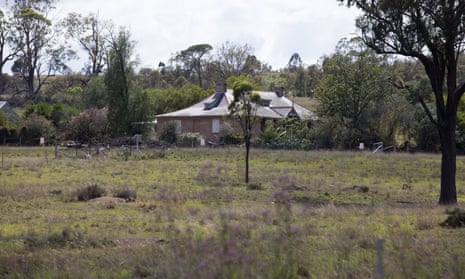Mining giant Glencore has launched an extraordinary public attack on two Indigenous people who are seeking to stop the company destroying the site of an Aboriginal massacre in New South Wales.
Scott Franks and Robert Lester identify as Wonnarua people, the traditional landowners in the Upper Hunter. They have applied to protect Aboriginal massacre sites at the historic Ravensworth Homestead and surrounding lands near Singleton.
In an advertisement in the community newspaper Hunter River Times on 5 November, Glencore named Franks and Lester, stating that they are “seeking to stop our project”.
It alleges “independent studies of the written histories, including thorough investigation by a local historian, indicate that the September 1826 massacre in question occurred more than 20km away from the homestead site”.
The advertisement is a controversial intervention, coming after the public opprobrium experienced by mining company Rio Tinto after the destruction of the Juukan Gorge rock shelters in the Pilbara region of Western Australia.
The Ravensworth site has been owned and maintained by Glencore for the past 23 years, but plans to extend their existing Glendell open cut coalmine to include the Ravensworth Homestead has meant that the site would be impacted by mining operations.
The proposed extension is known as the Glendell continuation project, which Glencore says will extend the life of the mine until 2044 and extract 135m tonnes of coal and provide ongoing employment of 600 workers.
To enable the extension to proceed Glencore have proposed that they will either move the homestead to another part of the property or relocate it to the nearby village of Broke.
Both suggestions have been rejected by the Plains Clan of the Wonnarua People (PCWP), who describe the Ravensworth Homestead and surrounding land as “hallowed ground” of the Wonnarua people and the site of a series of massacres from the 1820s onwards.
Franks described the advertisement as a “flat-out attack on First Nations people”.
“We have been sledged in an open forum, this huge mining company has taken out a full page ad against two Aboriginal people because we are trying to protect our heritage,” Franks said.
The men deny any suggestion of misinformation and say that Glencore’s claims about the location and date of the massacre are wrong.
Asked to comment on the advertisement, a spokesperson for Glencore stated that they are “concerned by the amount of misinformation that has been published about our project” and that they “will seek to correct the record”.
Minister considers protection application
The public spat comes as the federal environment minister, Sussan Ley, considers a section 10 protection claim by Franks and Lester under the Aboriginal and Torres Strait Islander Heritage Protection Act (ATSIHP), designed to protect areas and objects that are of particular significance to Aboriginal and Torres Strait Islander people.
The application has the potential to protect a proposed area in the centre of the Upper Hunter’s thermal coal heartland, so a number of mining operations – most of which are owned by Glencore – could be impacted.
A map of the specified area published in a commonwealth gazette notice shows the area for which protection has been sought.
The map covers the entire area of Glencore’s proposed Glendell continuation project and possibly sections of the company’s five other nearby mining operations.
It could also impact sections of the proposed continuation project for Glencore’s and Yancoal’s Hunter Valley operations north and south projects.
On the edges of the map the nearby Bloomfield Group’s Rix’s Creek operation, as well as sections of Yancoal’s approved but yet to be developed south east open cut coal project near Singleton could also be impacted.
Under the ATSIHP act, Ley appointed a reporter to determine whether the criteria for the section 10 claim could be met.
The reporter has since submitted an independent report and Ley must now determine whether to protect the area. If she does accept the claim, it could be a landmark decision whereby Aboriginal culture is preserved in the Hunter Valley.

A spokesperson for the Agriculture, Water and the Environment Department confirmed the report had been received and would make the decision “in due course”.
“Parties have been provided an opportunity to comment on the content of the report for procedural fairness and a significant amount of additional information has been received by the department, which is under assessment. The application and related material is under assessment,” a spokesman said.
The Ravensworth Homestead complex was built around 1832 by Dr James Bowman, who was the principle surgeon for the colony of NSW.
Lyn MacBain, a local historian and former Singleton councillor, said: “Ravensworth has a history which ties Aboriginal heritage and European heritage”.
“They are intermingled, which is why Ravensworth Estate is a prime location to be protected to allow reconciliation in the Hunter Valley.”
The shock and public reaction to the destruction of the Juukan Gorge in WA led to a federal parliamentary inquiry to examine why it occurred and how best to protect First Nations cultural heritage.
The final report, titled A Way Forward, emphasised that a “loss of cultural heritage diminishes the heritage of our nation and deeply wounds the Aboriginal and Torres Strait Islander peoples for whom this heritage is sacred”.
The report, while expressing that Rio Tinto’s “actions demonstrated the profound lack of care for Aboriginal and Torres Strait Islander heritage in this country”, also indicated that “perhaps the tragedy may at least be a catalyst for change”.
Rana Koroglu, the NSW managing lawyer of the Environmental Defenders Office, who is currently representing the PCWP, said: “Glencore’s offensive ad aimed at our clients is yet another example of a multinational coal mining company attempting to intimidate First Nations peoples who are seeking to lawfully exercise their human rights to protect their cultural heritage.”
Sophie Nichols is a freelance journalist based in the Hunter Valley.









